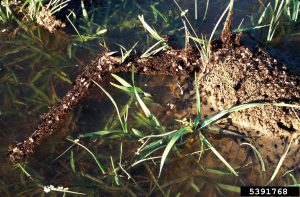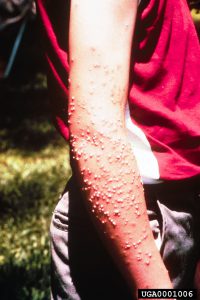
Post-storm cleanup is something we all want to start as soon as possible after the storm passes. However, we need to be very cautious and aware of the possibility of potential hazards, like downed electrical lines, sub-surface debris and… fire ant rafts.
Yes, THAT red imported fire ant (RIFA). The one that bites and stings and leaves a lasting impression of agony, itchiness, and pustules. Amazingly, these insects can and do create “rafts” made entirely of interconnected ants to float away on flood waters.

As the water rises, the ants get flooded out of their subterranean nests. The ants then band together to form a biological, floating raft or ball, with such high surface tension and strong connections that they are nearly impossible to break apart. The ants then carry their queen, workers, and larvae (the immatures) on top of the raft and “float” to higher ground.
What is ‘Higher Ground’?
Keep in mind that higher ground can be anything that is dry: a tree, a dead palm frond, a debris pile, or your leg. Once they come in contact with a dry object (think your leg), they will start to offload their members. And, the soldiers and workers will defend those nestmates by attacking the “enemy” with unrelenting bites and stings.
Be prepared when going outside to clean-up debris
When heading outside to start your post-storm cleaning, make sure to wear work gloves, closed-toe shoes, long sleeves and long pants. Be on the lookout for floating brownish-red areas that look like small particles of debris or mulch. More than likely, these are living rafts of RIFA colonies.
What NOT TO DO if you encounter a floating RIFA ant raft
- Do Not try to push the colony down into the water to drown them. They will not go underwater, but they will go into attack mode.
- Do Not try to scoop them up with a pool net or any other object.
- Do Not try to toss water on the raft, as this will only dissipate some of the raft, provoking hundreds of ants to turn on the “attacker.”
What you CAN DO
-
- Fill a water spray bottle with diluted dishwashing soap at a ratio of two tablespoons dish soap to one gallon of water.
- Apply the soapy mixture as a spray over the top of the raft.
This soapy mixture will break the surface tension of the water. This causes the ants to sink, and they will soon drown.
What to do if ants get on you:

If ants get on your skin or clothes, quickly brush them off with your hand or use a handheld whisk broom. Attempting to remove them with a stream of water or jumping into a pool will not help, as they will just tighten their hold.
If you or someone you know is allergic to fire ant bites/stings, seek medical attention. When the ants attack, a mixture of alkaloids is injected through the sting. Dabbing white vinegar onto the affected area may help neutralize the stings. Applying an over-the-counter hydrocortisone cream to the area may also help in alleviating the itchiness.
Resources:
 2
2
